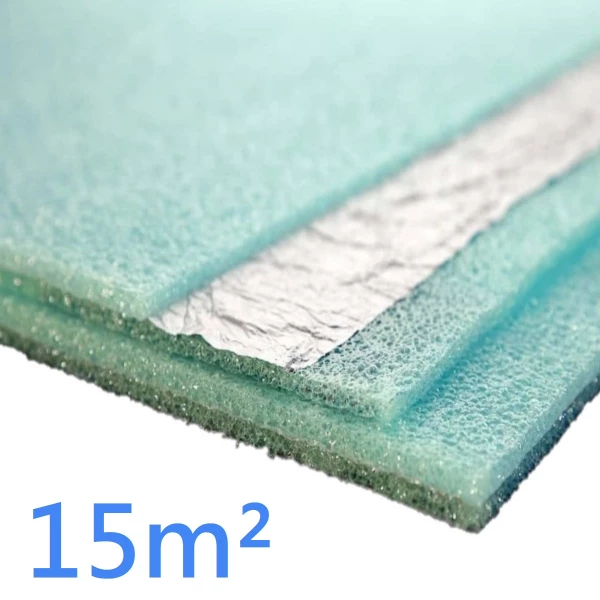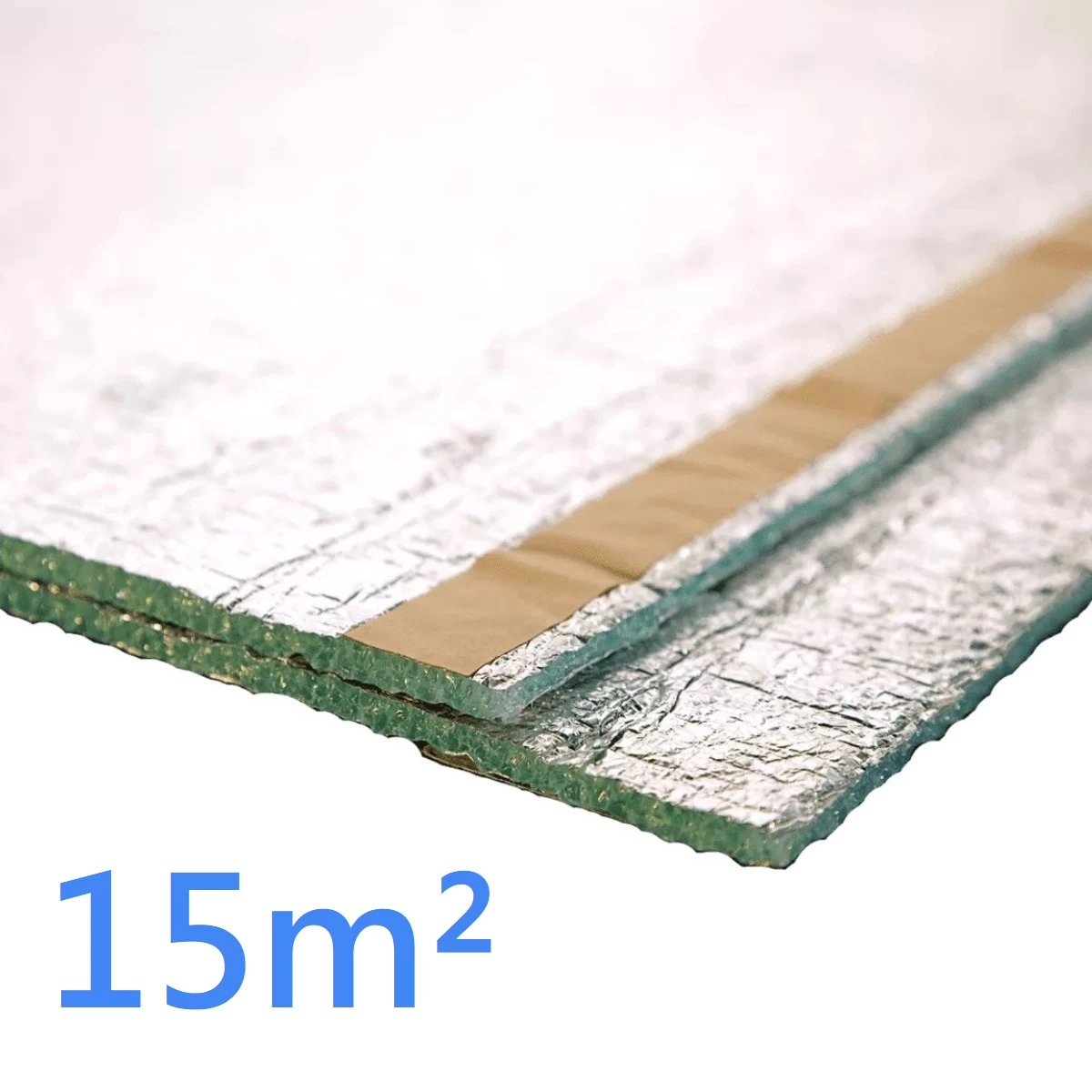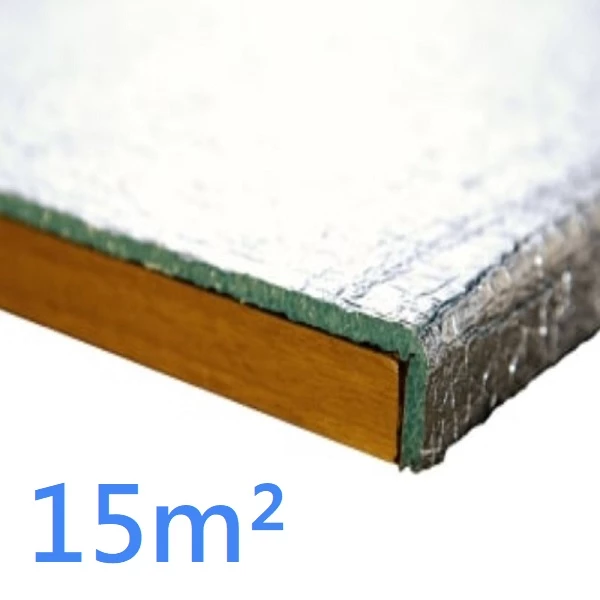
Related
More from this brand
- Low-E SlabShield Reflective Foil Insulation VCL 15m2
- Innovative interlocking 11mm thick air infiltration barrier
- Vapour barrier designed to boost thermal performance
- SlabShield Foil Insulation Low-E Vapour Control Layer
- Lightweight and cuts easily with a utility knife or scissors
In Stock
- Brand: Low-E™
- Model: Low-E SlabShield 15m2
- Weight: 4.35kg
- Dimensions: 12,000mm x 1,250mm x 11mm
- SKU: Low-E SlabShield 15m2
- Product code: P1-2398
- MPN: Low-E L4FSFB-15
Options available
- Description
- Specifications
- Reviews
- FAQs
- Product videos
- Delivery
- Price per m2
- Stockists & Installers
- Trade Prices
Low-E SlabShield Reflective Foil Insulation VCL is an innovative interlocking 11mm thick air infiltration barrier and vapour barrier designed to boost thermal performance, in one simple to install product that can be used for under concrete slabs both with, and without, hydronic heating systems.
11mm SlabShield VCL Insulation has innovative interlocking tabs that provide a perfect seam when using several rolls side by side.
The edges are overlapped and taped to maintain a continuous Vapour Control Layer.
Low-E SlabShield will not crack or crumble with normal job-site-abuses, because it is puncture resistant up to 93 psi and crush resistant up to 70 psi.
With one of the lowest carbon footprints of any insulation material Low-E SlabShield Reflective Insulation is the thinnest most effective reflective foil insulations available on the market designed to last.
SlabShield is only 11mm thick and will mould itself to the contours of the subfloor, to provide a better and stronger finished floor.
With a Class A, Class 1 Fire Rating, Low-E SlabShield stops heat, deadens sound and provides moisture control all in one product
Unlike some other insulation materials that off gases, Low-E SlabShield is totally non-toxic and with no fibres and no itching.
SlabShield is robust enough to take a pour of over 150mm of concrete but requires a minimum 60mm pour of concrete to reduce risk of movement or cracking.
It is lightweight and cuts easily with a utility knife or scissors.
Specification:
Thickness: 11mm
Roll Width: 1250mm
Roll Length: 12000mm
Roll Coverage: 15m²
Weight: 290g per m²
Roll weight: 4.35kg
MVTR: >2000 MN s/g
Air Permeability: Zero - m3 hr-1 m-2 (600 Pa)
Core Conductivity: 0.0366 Wm²K
Product Type: Type 2 EN 16012
Emissivity: 0.05 to EN 16012
Facing Material: 99.4% Pure Aluminium
Core Material: Recycled Closed Cell Polyethylene
SlabShield Key points:
· Reduces slab response time.
· Excellent vapour barrier.
· Exclusive interlocking tabs.
· Convenient and lightweight.
· Puncture resistant to 93 psi.
· Crush resistant to 70 psi.
· Superior thermal performance.
· Closed cell foam (not bubble wrap).
· Retains curing moisture for stronger concrete.
· Totally non-toxic and with no fibres and no itching.
Low-E SlabShield Features:
To provide greater comfort and energy efficient living, the easiest way to stop heat transfer between ground and slab, is to install Low-E SlabShield insulation.
Build energy efficient structures from the ground up by using revolutionary SlabShield.
Developed with the same Low-E energy efficient technology that goes into Low-E Reflective Insulation, SlabShield offers unique benefits not found in other under slab products.
SlabShield is engineered to not only help prevent heat transfer from ground to slab but also to provide a vapor barrier that protects from excess moisture.
Low-E SlabShield is puncture resistant up to 93 psi and crush resistant up to 70 psi.
Unlike other rigid under slab insulation, SlabShield adjusts and moulds itself to the contours of the grade providing a better and stronger concrete pour.
SlabShield is easy to apply and will not crack or break like traditional board insulation when walked on.
It is lightweight and cuts easily with a utility knife.
It comes in rolls with innovative interlocking tabs that provide a perfect seam when using several rolls side by side.
*Further information may be found in our Downloads section.
Fairly easy access to all PDF files.
Datasheet ǀ Declaration of Performance - DoP ǀ BBA Certificate ǀ Installation Guide ǀ Certificates ǀ Brochure ǀ SPEC Sheet
| specification | |
| Board covarage | 15 m2 |
| Colour | Silver ǀ Aluminium |
| Length | 12000mm |
| Material | Aluminium ǀ Recycled Foam |
| Profile | Air infiltration barrier and Vapour barrier |
| Thickness | 11.0mm |
| Weight | 290g per m² |
| Width | 1250mm |
| Vapour Resistivity | 2000MN.s/g.m |
| Coverage | 15.00 m2 |
| Fire performance | Class 1 ǀ Class A |
| Shipping method | Courier |
| Applications | Under Concrete Slabs |
| Foil faced | Yes, 99.4% Pure Aluminium |
| Features | Innovative Interlocking Vapour Barrier |
| Manufacturer | Low-E® Insulation |
What is Low-E™ Reflective Foil Insulation?
Low-E™ reflective foil insulation is a material that reduces the rate of radiant heat transfer across air spaces by use of one or more highly-reflective surfaces.
How Low-E™ can help save energy?
Low-E™ reflective foil insulation can effectively re-direct heat back towards its source. Therefore, in the summer, you want the heat re-directed away from your home, but in the winter, you want the heat residing in your home to remain there. This provides for a more efficient system year round.
What is the Low-E™ made off?
The materials that Low-E™ insulation is made of is a 80% recycled foam polyethylene core and an aluminum facings.
What makes Low-E™ product so good?
Reflective foil insulation creates a radiant barrier system that reflects radiant heat instead of absorbing it into the building structure. Because of its low emissivity, radiation through the material is significantly reduced, giving Low-E™ foils a high thermal resistance. This product is very good, due to the inherent nature of foils which has an extremely high reflectivity of 97% and very low emissivity of 3% for re-radiation.
How Low-E™ Reflective Foil works?
It works completely differently to other insulation materials. The way Low-E™ works is instead of slowing down heat transfer, the way traditional insulation does, reflective foil insulation block 97% energy transfer in and out of the structure. Unlike mass insulation which only slows down or resists heat transfer. Low-E™ reflects heat.
What is the space required for Low-E™ application?
The reflective insulation benefit is derived from the interaction of the highly-reflective surface with the air space. A minimum of 25mm of air space is required on the reflective side of the product. Air spaces are required to provide the stated R-value.
Low-E™- what is designed for?
It is designed to reduce life cycle running costs, provide moisture protection, stops droughts, deaden sound but most importantly, to tackle issues which are usually left unaddressed by traditional bulkier insulation products.
Where Low-E™ can be installed?
In construction, Low-E™ Insulation is used in Walls, Floors and Roofs either in commercial or domestic buildings. It can also be applied in camper vans and motor homes. Its applications extend to tents, spa pools, saunas and steam rooms.
What are main differences between Low-E™ and traditional insulation?
Traditional insulation products such as fiberglass or foam board are effective in reducing convective and conductive heat transfer, but do very little to prevent radiant heat transfer. Low-E™ bounce reflects back heat toward the source. Low-E™ foil is not like mass insulation which can only slow down or resist heat transfer. Low-E™ reflects heat.
How good is Reflective Foil Insulation in terms of acoustic performance?
Reflective foil insulation will help deaden sound up to 50 percent under.
Does it matter which side of the Low-E™ foil faces up?
Low-E™ can be installed any which way and you'll get the same performance. The material works equally well on both sides.
Will Low-E™ reflective insulation foil prevent condensation?
When installed properly, with taped seams, condensation will not occur on the surface of the reflective insulation. The thermal break provided by the air space prevents warm, moist air inside a building from interacting with cold air on the same surface.
How much Low-E™ reflective foil will I need for my campervan/caravan installation?
It is recommend overestimating the amount that you will need as it is better to have a little too much than be left short.
For more info click here
How does Low-E insulate well if it is so thin?
Thinner reflective material can easily provide better thermal performance than a thicker non-reflective product with a higher R-Value.
Does Low-E Radiant Barrier degrade?
Low-E™ reflective foil insulation is made from polyethylene and aluminum. Both of these materials are very environmentally stable and do not biodegrade quickly.
Will dust affect the performance of the Low-E™ foil?
Yes, dust do have an effect on the material’s ability to reflect radiant energy.
What is the benefit to adding Low-E™ reflective foil insulation to my roof?
Low-E™ reflective foil insulation provides increased comfort, energy savings and condensation control. Low-E™ is an investment that you will see a great return on.
Is Low-E™ environmentally friendly?
Low-E™ helps the environment as there is no need to have your heating on as high or as long, you will be using less non-renewable energy, and releasing less carbon into the atmosphere.
Is Low-E™ moisture resistant?
This type of insulation is not affected by moisture or humidity and performs at the same level no matter what the outside weather conditions are.
It is among the few insulations that is not affected by humidity. Its insulating value remains unchanged whether in a dry or very humid climate.
What are the advantages of Low-E™ insulations and traditional insulation?
Ease of installation and diversity of applications are two major advantages.
Why must Low-E reflective insulation be installed adjacent to an air space?
An air space allows heat to be converted into radiant energy. Installing Low-E™ reflective foil insulation adjacent to an air space allows this radiant energy to be reflected away from the building envelope.
Do I have to take out my old insulation to put a Low-E™ reflective foil insulation in?
No, Low-E™ reflective foil actually makes your present insulation more effective.
Can Low-E™ reflective foil insulation be used with other conventional insulation materials?
Yes, reflective foil insulation used in conjunction with other conventional insulation materials creates a highly energy efficient insulation combination.
How good is Low-E™ in terms of savings?
By allowing ONLY 3% of radiant energy to pass through, you will see noticeable savings on your next heating and cooling bills. Energy savings for heating and cooling can be as much as 20%, depending on a number of factors, including climate, building configuration, materials used, site, family size and lifestyle. Foil insulation can help reduce your heating bills by maintaining your home’s internal temperature. In the long run, the investment in foil insulation far recoups itself through savings in energy bills.
What is the R-Value of Low-E™ insulation?
Foil insulation achieves an R-value in two ways. The first is through the resistance of the core of the material. R-values for reflective insulations are dependent on two criteria:
1. Heat flow direction
2. The amount of air space in a closed cavity on the reflective side of the product in a building assemblage.
This is the reason why Low-E™ has different R-values for different applications.
Second is through the air layer adjacent to the foil surface. Low-E™ insulation does have tested R-values but more importantly, its aluminum surfaces have an emissivity of 0.03, which equates to 97% of radiant heat being stopped and reflected back to its source.
Where do you install a Low-E™?
Low-E™ reflective foil can be laid over your present insulation like a blanket or stapled under your rafters.
Doubling the Low-E™ product doubles the benefit?
By doubling up Low-E™ means just adding a second layer of reflective insulation without increasing the number of air spaces, that is if both layers of insulation are in contact with each other, essentially the only increase in thermal value would be the intrinsic R-value of the added layer. If the product is simply “doubled” (with no air space between the layers), a very minimal benefit is obtained. With multiple layers of product and airspace between each layer, enhanced performance will be gained.
What if there is no air space present on either side of the Low-E™ foil?
Generally speaking No Air Space = No Reflective Insulation Benefit.
Is Low-E™ reflective foil good in cold climate?
Low-E™ reflective foil provides significant benefits in cold climates where they are used alone or when used in combination with other insulation materials in specific applications.
What is the fire rating of Low-E™ insulation?
Low-E reflective foil insulation has a Class A/Class 1 Fire Rating.
How much money will I save on my electric bill with a Low-E™ insulation?
A savings of up to 10% off your air conditioning usage are typical.
Will Low-E™ affect my mobile phone use?
No, the Low-E™ will NOT affect your mobile phone use at all.
How do I install Low-E™ reflective foil insulation on my loft?
The preferred method is stapling it under your rafters.
Do I need a Low-E™ reflective foil if my home is already well insulated?
A Low-E™ reflective foil can stop 97 percent of the thermal radiation across an attic space. If it is not stopped, that radiant energy would be absorbed by the ceiling insulation and eventually be transferred to the living space below.
Is Low-E™ reflective foil effective in the winter?
Yes. It will reduce your heat loss significantly in your home. Energy Low-E™ foil insulation has year round benefits.
What are Disadvantages of Reflective Insulation?
It is generally more expensive due to being a metal-based product. It also relies on being clean and free of dust and debris, both when fitted and when in use. This means in some areas, such as roofs, it may require being cleaned of dust from time to time to ensure maximum efficiency.
We deliver insulation materials to Mainland UK only. Deliveries to Highlands, Northern Ireland, Isle of Wight etc.. might be possible at additional cost.
We offer free delivery on most of the orders above £300 (excluding VAT) (except special products - shipping cost via courier - products marked ''Request A Quote'')
Delivery of some insulation materials might be extended due to the current situation (Covid-19, stock shortages, allocations).
If you need materials quickly please contact us - we will do our best to help you source materials needed.
We do not deliver on weekends and bank holidays. Sometimes we can deliver on Saturdays - please check with us before placing the order.
If you need any further information please contact us tel. 02081910776
We can help to calculate price per m2 or linear meter (one meter in length) cost, please just contact us via phone 02081910776, email or live chat. Alternatively, you can work it out yourself quickly and easily: to get cost per meter square please divide price shown in orange area by ''Required area (m2)'' Example price of £28.80 divided by board coverage 2.88m2 = cost of £10.00 per m2.
INSTALLERS
No matter whether you choose a local installer or a national company, there’s a few tips to help you find the right installer for your home insulation improvements, such as asking for recommendations and making sure that they’re part of a certification scheme. This makes sure that they have the right skills and standards of workmanship to carry out the installation, and you can be sure that they know exactly what they are doing.
4 TIPS FOR CHOOSING THE BEST INSULATION INSTALLER
1. Thermal inspection picture in portfolio
It’s worth seeing a installer’s previous work. There’s no harm asking if you can see any properties nearby that they’ve installed insulation in. Best way would be to see Infrared Thermal Imaging Inspections. Thermal cameras spot small, but key changes in temperature in different areas of a house, identifying problematic areas that the human eye never could and some that a visual inspection could only hypothesize.
2. Reviews
Along with checking recommendations and previous work, finding reviews online can often be a great way to find out if they provide a good service or not. However, it’s best not to solely rely on reviews you may find or review websites, as there’s no controlling who writes them.
3. Compare prices
Comparing prices will also ensure companies can’t take advantage of you and give you a fair price.
4. Word of Mouth
The best way to find a great insulation installer is through recommendations. Make sure you ask friends and family. They will most likely give you their honest opinion and can tell you from first hand experience.
Whether you require a wall, cladding, external wall, loft or floor insulation fitted, you can find and hire your local insulation installers from popular UK web pages. A simple internet search will return thousands of potential installers near your area.
https://www.nia-uk.org/find-an-installer/
https://www.ratedpeople.com/local-thermal-insulation
STOCKIST
We are the stockist of construction materials and related products for both trade and DIY from most recognizable brands in the UK like Cordek, RCM, Promat, Rockwool, Isover, Celotex, Xtratherm, Ursa, Low-E, Cedral, Kingspan, Dufaylite, British Gypsum, K-rend, Ecotherm, Iko enertherm, Kay-Metzeler, Terrawool to allow you to complete your insulation job on time at competitive prices and the highest standards.































































































































